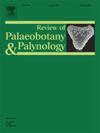Vegetation and environmental changes on the Northeast China Plain during warm periods since MIS 3
IF 1.7
3区 地球科学
Q2 PALEONTOLOGY
引用次数: 0
Abstract
Understanding past terrestrial ecosystem responses to climate changes is vital for future predictions, but research in densely populated plains is limited due to insufficient materials. This study focuses on vegetation and environmental changes in the Northeast China Plain since Marine Isotopic Stage (MIS) 3 using pollen analysis from core WCZK03. The findings reveal significant shifts in vegetation that correspond to climatic events. During MIS 3 (52–29 cal ka BP), the region was predominantly a lake environment with vegetation transitioning from grassland dominated by Poaceae, Chenopodiaceae and Artemisia to conifer-broadleaf mixed forests as the climate ameliorated. The Last Glacial Maximum (29–17 cal ka BP) was characterized by loess deposits, followed by drought-tolerant grassland (17.0–11.3 cal ka BP) dominated by Artemisia and Chenopodiaceae in the plain. The onset of the Holocene witnessed the expansion of conifer and broad-leaved deciduous forests in hilly areas and the retreat of grassland in the plain. The sedimentary sequence shows transitions from fluvial-lacustrine deposits to loess-like and black soil deposits, showing significant environmental changes. This study suggests that changes in vegetation on the Northeast China Plain were closely related to regional climate patterns and were more responsive to climate changes than the surrounding mountainous areas.
自 MIS 3 以来温暖时期中国东北平原的植被和环境变化
了解过去陆地生态系统对气候变化的响应对预测未来至关重要,但由于材料不足,在人口稠密的平原地区开展的研究十分有限。本研究利用 WCZK03 核心区的花粉分析,重点研究了自海洋同位素阶段(MIS)3 以来中国东北平原的植被和环境变化。研究结果显示,植被发生了与气候事件相对应的重大变化。在 MIS 3(52-29 cal ka BP)期间,该地区主要是湖泊环境,随着气候的改善,植被从以禾本科、藜科和蒿科植物为主的草原过渡到针叶阔叶混交林。末次冰川极盛时期(29-17 卡 ka BP)的特征是黄土沉积,随后是平原地区以蒿草和藜科植物为主的耐旱草原(17.0-11.3 卡 ka BP)。全新世开始后,针叶林和落叶阔叶林在丘陵地区扩展,草原在平原地区退缩。沉积序列显示了从河流-湖泊沉积到黄土状沉积和黑土沉积的过渡,显示了显著的环境变化。这项研究表明,中国东北平原植被的变化与区域气候模式密切相关,对气候变化的反应比周边山区更为灵敏。
本文章由计算机程序翻译,如有差异,请以英文原文为准。
求助全文
约1分钟内获得全文
求助全文
来源期刊
CiteScore
3.50
自引率
21.10%
发文量
149
审稿时长
6 months
期刊介绍:
The Review of Palaeobotany and Palynology is an international journal for articles in all fields of palaeobotany and palynology dealing with all groups, ranging from marine palynomorphs to higher land plants. Original contributions and comprehensive review papers should appeal to an international audience. Typical topics include but are not restricted to systematics, evolution, palaeobiology, palaeoecology, biostratigraphy, biochronology, palaeoclimatology, paleogeography, taphonomy, palaeoenvironmental reconstructions, vegetation history, and practical applications of palaeobotany and palynology, e.g. in coal and petroleum geology and archaeology. The journal especially encourages the publication of articles in which palaeobotany and palynology are applied for solving fundamental geological and biological problems as well as innovative and interdisciplinary approaches.

 求助内容:
求助内容: 应助结果提醒方式:
应助结果提醒方式:


